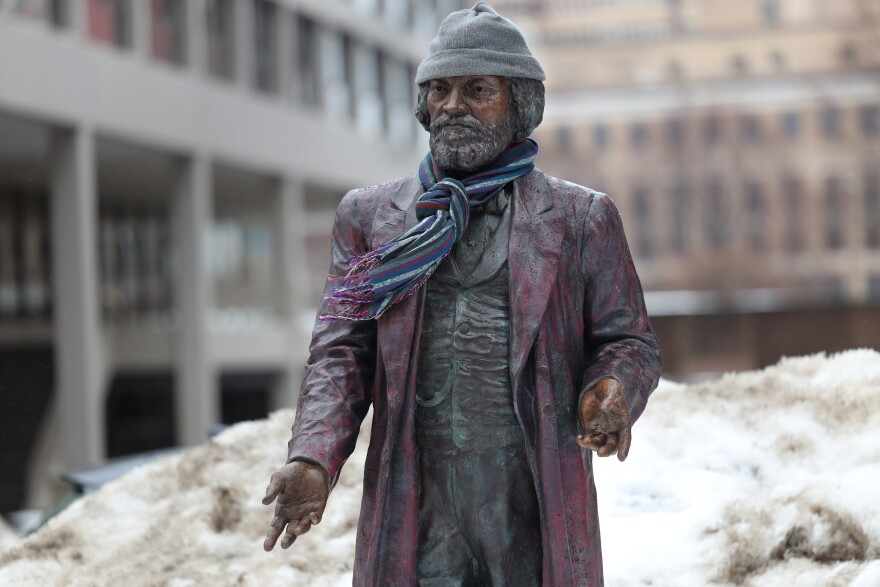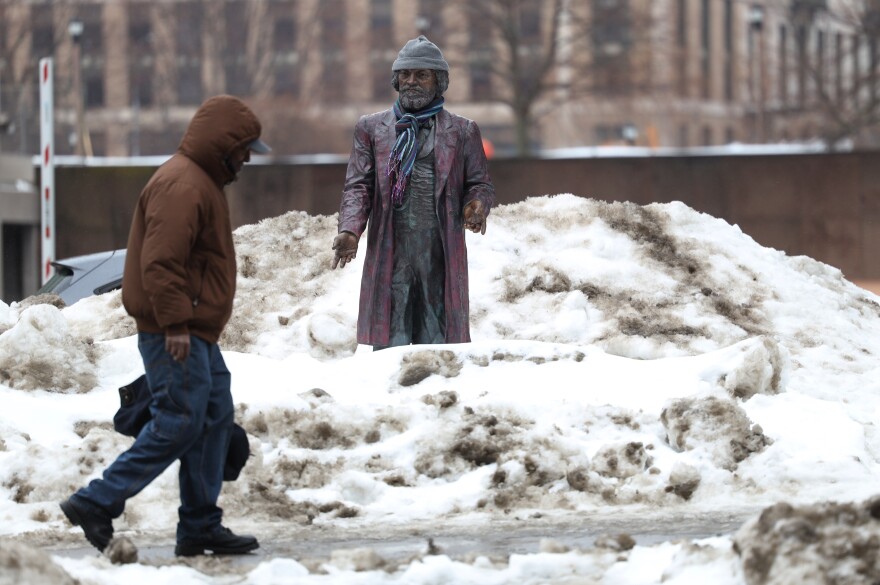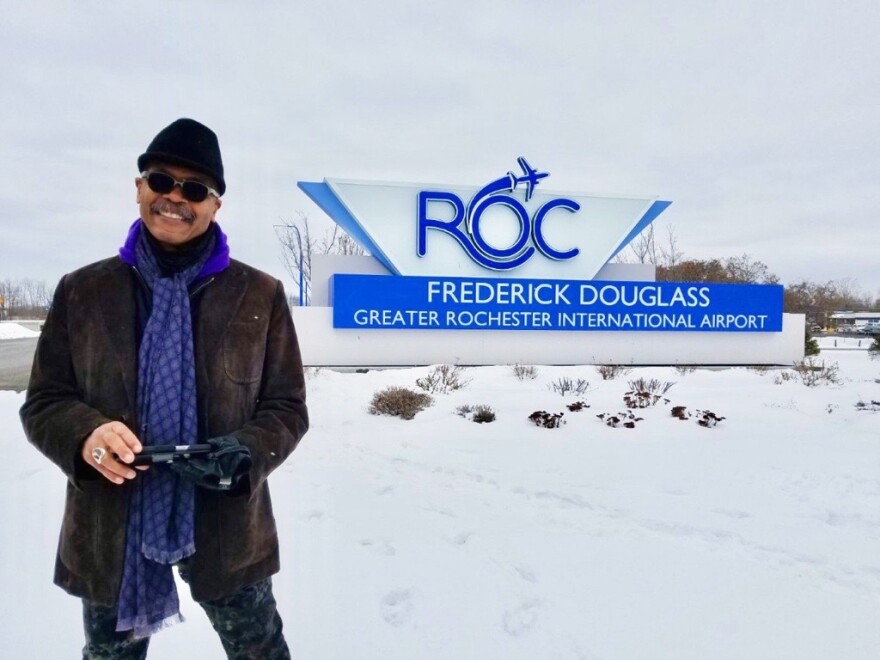The name of one of the great abolitionists now finds itself in rare air: Our rather pedestrian-monikered airport has been renamed the Frederick Douglass Greater Rochester International Airport.
“For Rochester to do that once again reinforces the social justice history, the social justice recognition, that has always been here,” says Carvin Eison.
Not to besmirch the contributions of cartoonists to this nation -- Charles M. Schulz Sonoma County Airport -- but when it comes to naming airports after prominent Black Americans, the bar has been set pretty high. There’s the Baltimore/Washington International Thurgood Marshall Airport. New Orleans’ airport is named for Louis Armstrong. Atlanta’s airport honors Maynard Jackson, the first Black mayor of a major southern city. In Jackson, Mississippi, the airport is named for civil rights activist Medgar Evers.
And now Rochester, which is not done with simply swapping out the sign in front of the airport. Eison, a journalism professor at SUNY Brockport and a filmmaker, is leading the way to erecting a bronze statue of Douglass at the airport as well.
“I think at a time when our nation is so bitterly divided,” Eison says, “this monument and the newly named Frederick Douglass Greater Rochester International Airport could serve as a model for our country. And boy, we need that right now.”
That divide came home to Rochester with the death of Daniel Prude. Just days after the renaming of the airport in honor of a Black man, a grand jury here declined to indict police officers whose actions, it has been alleged, led to the death of a Black man, Prude. Hundreds of protesters took to the streets that evening.

The rise of Douglass statues in Rochester stands in dramatic contrast to the resistance, mainly in the South, to stone-faced Confederate generals being yanked from their pedestals. Like the wooden cigar-store Indian in the Memorial Art Gallery, the home for such pieces is a museum. Not for celebration. But where we can reflect on where we went wrong. And corrected that course.
(I write this as a longtime fan of Cleveland’s Major League Baseball team, and now an advocate for changing the team’s nickname and its accompanying racist logo.)
Old brands die hard, but enlightenment should always be welcome as we move from the shadows of the past. In the past year, The Dixie Chicks announced they will distance themselves from the Confederacy, and are now simply The Chicks. And the country trio Lady Antebellum, looking to set aside its association with a word that recalls the pre-Civil War days of Southern slavery, have said it will henceforth be known as Lady A.
So the present is not excluded from this debate.
“I think about people like Garth Fagan, for example,” says Eison, “who would be to the arts in many ways what Frederick Douglass may have been to the general culture, as a statesman, as an ambassador, as a writer, as a thinker, an orator. Here’s someone who is still with us now and we don’t think about those things. We tend not to think about the significance of people like that.”
Eison’s mission to place a Douglass statue in the Rochester airport has been awarded grants from the National Endowment for the Arts and the National Endowment for the Humanities. “Those are two of the most difficult grants to get,” he says.

But there’s still a long way to go. Eison estimates the cost at $250,000. And there will be add-ons, including a kiosk with a film and information for visitors to the city that explains Douglass’ relationship to Rochester. Eison will be setting up fundraising through Rochester’s Community Media Center and douglasstour.com.
There is a strong through-line from Douglass’ historical connection to Rochester and his emergence at the Frederick Douglass Greater Rochester International Airport. Eison starts with the 1899 statue created by Stanley Edwards. He says it was Rochester’s mayor at the time, George Warner, who wanted visitors arriving to the city by train to know one of Rochester’s most illustrious citizens.
That Douglass statue has been pretty limber for an 8-foot-tall bronze. In 1941, it migrated from the old New York Central Train Station on St. Paul Street to a serene spot overlooking Highland Bowl, not far from where Douglass’ home was on South Avenue.
The statue went on the move again in 2019, to a more prominent spot at the new Frederick Douglass Memorial Plaza at South Avenue and Robinson Street. Where it will greet visitors to future Lilac Festivals, COVID-19 willing.
Douglass, who died in 1895, never saw an airplane. But Eison sees a Douglass presence in the airport that now bears his name as essential. Because now the airport is to travel what the train station once was.
“By placing a monument of Frederick Douglass in the modern portal of travel,” Eison says, “we are saying to all people who come in and out and who come through that airport -- pose to take a picture with it, I hope -- we’re saying that these values are still the values that we uphold. We’re saying that Frederick Douglass, the things that he deported, the notions that he perpetuated, his relentless support of abolition. His support for the suffrage movement, his support for literacy and -- this is the one that people often don’t write about -- his support for telling the truth.”
Truth, as in the brutal history of race in the United States. “At a time when monuments are placed in the public sphere in communities that serve to separate those communities,” Eison says, “the Frederick Douglass monument has always served to bring our community together.”
The new generation of Douglass statues was born in 2018 in the Hungerford Building studio of artist Olivia Kim. In what was called The Monuments Project, Kim created 13 fiberglass statues that were scattered around the city at locations that bore some meaning to Douglass. The statues have a similarly powerful yet benevolent bearing to Edwards’ statue. In real life, Douglass was a physical presence over 6 feet tall, although not quite the stature of Kim’s rendering of 6 feet, 7 inches.
But Kim did strive for genetic authenticity for two other physical features of her work. Ken Morris Jr., who lives in Orange County, California, is a great-great-great-grandson of Douglass. Kim used casts of his hands and face to shape her statues.
“I think that is an exceptional idea,” Eison says. “It is sort of connecting the past with the present. This kind of idea that the hands of the present connect back to the hands of Frederick Douglass and the past.”
Douglass presents a sense of place. A Rochester place. But often, we look right past that. In 2016, “Lunar Eclipse,” a towering abstract clock by world-renowned wood sculptor and Rochester resident Wendell Castle, was removed from the airport and placed in storage. As was the monolithic “Triad,” by ceramic artist Nancy Jurs, whose works are in the collection of the Smithsonian Institution, the Museum of Art and Design and the Memorial Art Gallery. Other works of art as well were moved out, making room for advertising, and revenue for the airport.

Yet public art is not only a sense of place, it is a message. A spectacular mural was recently completed on the side of a building on State Street: The late Georgia Congressman John Lewis had no connection to Rochester, other than the shared struggle by Black Americans for their civil rights.
“Any kind of public art work, public monument, right now in American culture is controversial,” Eison says. “Because who has the right to say what goes to represent what people in that community think?”
Eison reaches back to the Egyptian pyramids, and the paintings on those crypt walls celebrating the stories of their lives, as a deeply human expression.
“And then, with that as an expression, along comes another culture, and desecrates that culture, right?” Eison says. “We experienced that with The Monuments Project, we acted and put something on the street, something that I knew, I knew that something would happen, I just didn’t know when. And less than six months after we put these monuments in the street, someone else comes along and desecrates it. Someone else comes along and vandalizes it. And tears it down.”
When the original Douglass statue resided in Highland Bowl, the head of one of his neighbors, the German writer Johann Wolfgang von Goethe, was ripped from its base in 2015 and carted away, not to be seen again. And for reasons unknown, two of the 13 Douglass statues created by Kim have been vandalized since they were installed; in one case, two St. John Fisher College students confessed to the act, an evening of drunken hooliganism.
The reaction to destroy something, Eison says, “is just as human, although not appreciated in the same way, as the act of putting the monument up in the first place.”
These are, he says, “actions that say who we are.” With that duality in mind, Eison’s concept for the kiosk accompanying the Douglass airport statue would include commentary on “monuments in public places and how they polarize communities,” he says.
Perhaps there will be hope included in that commentary. In an act of contrition, the two college students who destroyed one of Kim’s statues returned to the scene of the crime, at Tracy and Alexander streets, to help set up a replacement Douglass.
So Douglass lives. Through colorful street portraits around the city by artists such as Dellarious and Shawn Dunwoody. And through the welcoming, upturned palms on the hands of the Douglass statues. And the notions that he perpetuated, including “the one that people often don’t write about … his support for telling the truth.”
“He is still affecting public policy, he is still commanding a spot on the 6 o’clock news,” Eison says. “And that is something extraordinary to me.
“We are just the custodians of this moment, and it will be up to people in the future to decide if that effort was worth it or not.”
Jeff Spevak is WXXI’s Arts & Life editor and reporter. He can be reached at jspevak@wxxi.org.


